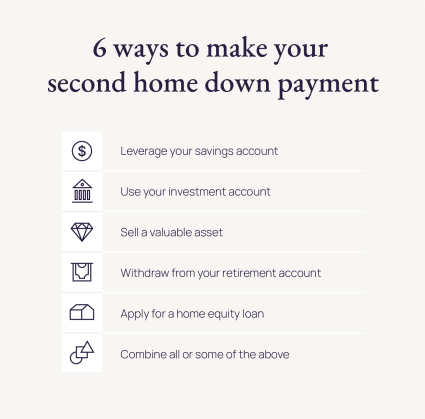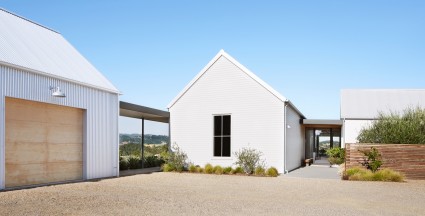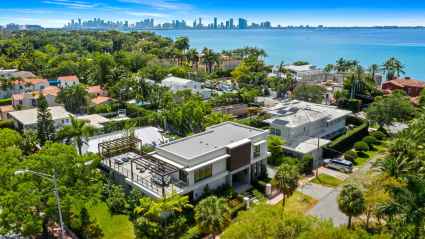But first, are second home down payments always required?
In the majority of cases, a down payment on a second home is required. If you plan to pursue a conventional loan for financing a second home, you’ll need to put money down upfront since they aren’t backed by the government. Even if you plan to pay for the home entirely in cash, you’re still technically putting down a large payment. If you plan to turn your second home into a primary residence, then it’s possible to get a government-backed loan. In that case, you won’t need a down payment for a second home.Stress-free second home ownership
How much do I need for a down payment on a second home?
The down payment for a first home can be as low as 0% and as high as 20% for a conventional loan. But the required down payment for a second home is around 10%, and sometimes more than 20%. The amount you’ll need for a down payment on a second home depends on several factors, including your credit score, your debt-to-income (DTI) ratio and the cost and type of property you’re purchasing. Down payments and interest rates for second homes can also vary depending on the lender, so it’s a good idea to shop around. Here is a closer look at how these factors can affect your down payment:- Credit score: The higher your credit score, the less money lenders will require for a down payment on a second home.
- Debt-to-income ratio: A lower DTI can often mean a lower down payment for your second home.
- Type of property: A second home classified as an investment property will require a higher down payment than one classified as a vacation home.
- Cost of property: Financing a less expensive property is a lower risk for a lender, so it will require less money down.
How can I fund my down payment on a second home?

1. Bank account
Using your personal bank account to fund your second home down payment is about as easy as it gets. The money is easy to move around and will only accrue low interest if left in the account. It may be smarter to use it rather than taking out a larger loan.| Pros | Cons |
| MONEY IN A BANK ACCOUNT IS EASY TO ACCESS AND TRANSFER AND WON’T ADD TO YOUR DEBT LOAD. | SPENDING TOO MUCH CASH ON A DOWN PAYMENT CAN REDUCE THE AMOUNT YOU HAVE ON HAND FOR THINGS LIKE HOME MAINTENANCE AND FURNISHINGS. |
2. Investment account
Using money from your investment account is similar to withdrawing it from your savings account. The only difference is that you may need to pay taxes on any gains the money made while it was invested.| Pros | Cons |
| MONEY IN INVESTMENT ACCOUNTS IS EASY TO ACCESS, AND USING IT WILL NOT AFFECT YOUR CREDIT SCORE. YOU MAY EVEN SEE A RETURN ON YOUR INVESTMENT IF YOUR SECOND HOME INCREASES IN VALUE OVER TIME. | THE REAL ESTATE MARKET CAN BE RISKIER THAN SOMETHING LIKE A MONEY MARKET ACCOUNT, SO THERE’S LESS CERTAINTY OF A RETURN ON YOUR INVESTMENT. |
3. Sale of an asset
Selling assets when you come up short on funds may be the only way to keep that second home of your dreams from slipping through your fingers.| Pros | Cons |
| SELLING AN ASSET TO FUND YOUR DOWN PAYMENT CAN SIMPLIFY YOUR FINANCIAL SITUATION AND LESSEN PHYSICAL AND FINANCIAL RESPONSIBILITIES. | LENDERS MAY BE LESS LIKELY TO GIVE YOU FAVORABLE TERMS IF YOU DON’T HAVE SOLID ASSETS FOR COLLATERAL. |
4. Retirement account
This second home down payment strategy is more age-sensitive than others, and isn’t recommended for people who plan on retiring in the near future.| Pros | Cons |
| THERE’S VERY LITTLE RISK INVOLVED WITH USING YOUR RETIREMENT FUND FOR A DOWN PAYMENT IF YOU HAVE PLENTY OF TIME BEFORE YOU RETIRE. | YOU WILL FACE PENALTIES, FEES AND TAXES ON THE MONEY YOU WITHDRAW FROM YOUR RETIREMENT FUND, MAKING IT AN EXPENSIVE FINANCING OPTION. |
5. Home equity loan or HELOC
Home equity loans are one of the most popular financing options for second home buyers. They work by taking out a line of credit against the equity you currently have in your primary home.| Pros | Cons |
| HOME EQUITY LOANS AND HOME EQUITY LINES OF CREDIT (HELOCS) TYPICALLY COME WITH LOW INTEREST RATES AND LARGE LOAN AMOUNTS. | THIS LOAN CAN AFFECT YOUR CREDIT SCORE AND DTI, LOWER YOUR CHANCES OF GETTING FINANCING, AND PUTS YOUR PRIMARY RESIDENCE AT RISK IF YOU CAN’T REPAY THE LOAN. |
6. Combine any of the above
While sticking to one funding source may not be enough for your down payment — or put you into financial jeopardy — using a mix-and-match approach may improve your situation.| Pros | Cons |
| MULTIPLE SOURCES CAN PROTECT YOUR CREDIT SCORE AND DTI, AND ENSURE YOU HAVE ENOUGH CASH ON HAND FOR EMERGENCIES. | ANY OF THE DRAWBACKS ABOVE MAY STILL APPLY, BUT WITH LESS IMPACT ON YOUR FINANCIAL SITUATION. |










